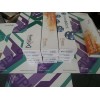品牌:上海惠诚生物
发货:3天内

| Cat. Number |
2039
|
| Chemical Name |
N-十九酰基神经鞘氨醇 N-Nonadecanoyl-D-erythro-sphingosine
|
| Mol. Formula |
C37H73NO3
|
| Mol. Weight |
580
|
| Qty 1 |
10mg
|
| Appearance |
solid
|
| Application Notes |
98+%,TLC; identity confirmed by MS
|
| Synonym |
N-C19:0-D-erythro-Ceramide
|
| Solubility |
chloroform, warm ethanol, warm methanol
|
| Storage condition |
-20℃
|
| References |
Application Notes: This product is a high purity ceramide containing an uncommon C19:0 fatty acid acylated to sphingosine making it ideal as an internal standard and for biological studies.1 Ceramide is a fatty acid amide of sphingosine. Ceramide functions as a precursor in the synthesis of sphingomyelin, glycosphingolipids, and of free sphingosine and fatty acids. The sphingosine can be phosphorylated to form sphingosine-1-phosphate. Two of ceramide’s metabolites, sphingosine-1-phosphate and glucosylceramide, produce cell proliferation and other cellular functions.2 Ceramide exerts numerous biological effects, including induction of cell maturation, cell cycle arrest, terminal cell differentiation, cell senescence, and cell death.3 Because of these effects ceramide has been investigated for its use in cancer treatment and many potential approaches to cancer therapy have been presented.4 Other effects include producing reactive oxygen in mitochondria (followed by apoptosis) and stimulating phosphorylation of certain proteins (especially mitogen activated protein). It also stimulates some protein phosphatases (especially protein phosphatase 2A) making it an important controller of protein activity.
References: |




